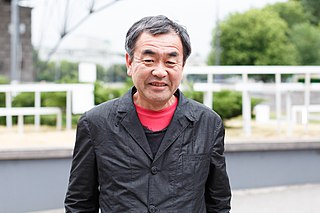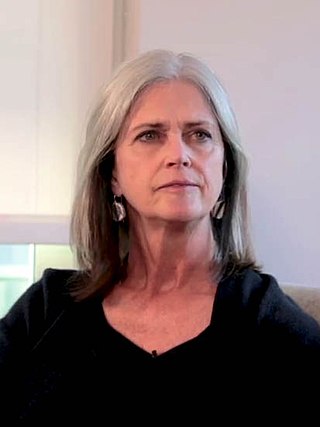Related Research Articles
Marjetica Potrč is an artist and architect based in Ljubljana, Slovenia. Potrč's interdisciplinary practice includes on-site projects, research, architectural case studies, and drawings. Her work documents and interprets contemporary architectural practices and the ways people live together. She is especially interested in social architecture and how communities and governments can work together to make stronger, more resilient cities. In later projects, she has also focused on the relationship between human society and nature, and advocated for the rights of nature.

Debra Jo Rupp is an American actress and comedian. She is best known for her starring role as Kitty Forman in the Fox sitcom That '70s Show (1998–2006) and its Netflix sequel series That '90s Show (2023–present). Rupp also had roles in the NBC sitcom Friends (1997–1998), the ABC animated series Teacher's Pet (2000–2002) and its 2004 sequel film, the ABC sitcom Better with You (2010–2011), and the Disney+ miniseries WandaVision (2021).

Sheila Hicks is an American artist. She is known for her innovative and experimental weavings and sculptural textile art that incorporate distinctive colors, natural materials, and personal narratives.

Jerusalem stone is a name applied to various types of pale limestone, dolomite and dolomitic limestone, common in and around Jerusalem that have been used in building since ancient times. One of these limestones, meleke, has been used in many of the region's most celebrated structures, including the Western Wall.
O'Donnell + Tuomey is an architectural practice based in Dublin, Ireland, described by the authors of Architects Today as one of "the godfathers of contemporary Irish architecture". O'Donnell and Tuomey were the recipients of the 2015 Royal Gold Medal, awarded by the RIBA.
Weiss/Manfredi is a multidisciplinary New York City-based design practice that combines landscape, architecture, infrastructure, and art. The firm's notable projects include the Seattle Art Museum's Olympic Sculpture Park, the Brooklyn Botanic Garden Visitor Center, the Tata Innovation Center at Cornell Tech, the Singh Center for Nanotechnology at the University of Pennsylvania, the Museum of the Earth, the Embassy of the United States, New Delhi, and Hunter's Point South Waterfront Park.

Kengo Kuma is a Japanese architect and emeritus professor in the Department of Architecture at the University of Tokyo. Frequently compared to contemporaries Shigeru Ban and Kazuyo Sejima, Kuma is also noted for his prolific writings. He is the designer of the Japan National Stadium in Tokyo, which was built for the 2020 Summer Olympics. He is married to architect Satoko Shinohara, and they have one son, Taichi, also an architect. He is an advisor for Kitakyushu-city in Japan.

The Sarasota School of Architecture, sometimes called Sarasota Modern, is a regional style of post-war modern architecture (1941–1966) that emerged on Florida's Central West Coast, in and around the city of Sarasota, Florida. It is characterized by open-plan structures, often with large planes of glass to facilitate natural illumination and ventilation, that address the unique indigenous requirements of the regional climate. Many of the architects who pioneered this style became world-renowned later in their careers, and several significant buildings remain in Sarasota today.

Ellen Lupton is a graphic designer, curator, writer, critic, and educator. Known for her love of typography, Lupton is the Betty Cooke and William O. Steinmetz Design Chair at Maryland Institute College of Art. Previously she was the Senior Curator of Contemporary Design at Cooper Hewitt, Smithsonian Design Museum in New York City and was named Curator Emerita after 30 years of service. She is the founding director of the Graphic Design M.F.A. degree program at Maryland Institute College of Art (MICA), where she also serves as director of the Center for Design Thinking. She has written numerous books on graphic design for a variety of audiences. She has contributed to several publications, including Print, Eye, I.D., Metropolis, and The New York Times.

The Revere Quality House is a house located in Siesta Key, Florida that was designed by architects Paul Rudolph and Ralph Twitchell. It is a breakthrough in twentieth-century residential architecture which blends elements of the International Style with site-sensitive design that is considered one of the notable examples of the Sarasota School of Architecture. The house represents a substantial advancement in how people should live within their environment, and established a new paradigm in tropical home construction.
Alice Adams is an American artist known for her sculpture and site-specific land art in the 1970s and for her major public art projects in transit systems, airports, university campuses and other urban sites throughout the United States since 1986. Her earlier work in tapestry and woven forms was important in the American fiber art movement.

Shilpa Architects is an international architecture, design and planning firm that was founded in 1979 in Chennai, India by Sheila Sri Prakash. The firm was established as a proprietary firm and is the first architecture firm that was founded independently by a woman in India.

Sheila Sri Prakash is an architect and urban designer of Indian origin. She is the founder of Shilpa Architects and is the first woman in India to have started and operated her own architectural practice.
Marilyn Jordan Taylor is an American architect, who has been a partner at Skidmore, Owings & Merrill since the early 1980s and served as its first female chairman. She specializes in urban architectural projects and designed the master plan for the Manhattanville expansion, the Consolidated Edison East River Greenway as well as airports from the John F. Kennedy International Airport terminal 4 expansion to the SkyCity at the Hong Kong International Airport. Between 2008 and 2016, she served as the Dean of the University of Pennsylvania School of Design.

Sigrid Lorenzen Rupp was a German-American architect. She ran a private practice, SLR Architects, in Palo Alto, California, from 1976 to 1998, and specialized in designing facilities for tech companies in Silicon Valley.
The Berkeley-Rupp Architecture Professorship and Prize is a prize awarded every two years by the University of California, Berkeley College of Environmental Design (UEC). The cash portion of the prize includes $100,000 awarded to the recipient. Recipients also earn a semester-long professorship at UC Berkeley. The prize is intended to honor a "distinguished design practitioner or academic who has made significant contributions to advance gender equity in the field of architecture, and whose work exhibits commitment to sustainability and community."

Anupama Kundoo is an Indian architect.

Deborah Berke is an American architect and academic. She is the founder of TenBerke, formerly Deborah Berke Partners, a New York City-based architectural design firm. Berke is currently Dean and J.M. Hoppin Professor at the Yale School of Architecture, where she began teaching as an associate professor in 1987. At the time of her appointment in 2016, Berke became the first woman Dean of the school. In 2022, Deborah received the AIA/ACSA Topaz Medallion for Excellence in Architectural Education.
Winka Dubbeldam is a Dutch architectural designer and academic. After her education in architectural design at Columbia University, she established her own firm, Archi-Tectonics, in 1994 in New York City. Her use of a combination of sustainable materials, innovative and inventive building methods with adoption of digital techniques has rewarded her with many accolades for her architectural projects. She has earned a reputation as a leading figure in modern architectural designs which has also made her "a real estate newsmaker". She is a Professor and Chair of architecture at the University of Pennsylvania. She is also the RIBA External Examiner for the Bartlett UCL London [2018-2022], the Creative Director for the Venice Biennale Virtual Italian Pavillion [2021]. Her Ted talk “Crowdfunding Urban Planning” was in TED Global in Edinburgh Scotland 2013.
softwall is a flexible room divider designed by Stephanie Forsythe and Todd MacAllen of molo. Made from paper or nonwoven polyethylene, the walls use a structured honeycomb geometry to bend, curve, expand and contract. The honeycomb structure also provides acoustic absorption. Part of a modular system, each softwall can connect to another by magnetic end panels. The walls have been used to create booths for trade fairs, pop-up retail, sculptural art installations, backdrops for performances, as well as to divide space in living and working environments.
References
- 1 2 Kalagas, Alexis (9 July 2012). "Let There Be (Portable) Light". The Global Journal. Archived from the original on 29 January 2013. Retrieved 13 October 2015.
- 1 2 3 "Faculty: Sheila Kennedy". MIT Architecture. Massachusetts Institute of Technology. Archived from the original on 17 February 2019. Retrieved 13 October 2015.
- 1 2 "Sheila Kennedy". Kennedy & Violich Architecture, Ltd. Retrieved 13 October 2015.
- 1 2 3 4 5 "About Sheila Kennedy, AIA and Her Work". Berkeley-Rupp Architecture. University of California, Berkeley. 2014. Retrieved 13 October 2015.
- ↑ Testado, Justine (16 September 2014). "Sheila Kennedy of KVA MATx Wins 2014 Berkeley-Rupp Prize". Archinect. Retrieved 13 October 2015.
- 1 2 3 4 5 Knecht, Barbara (2 October 2003). "Brave New Solid-State, Carbon-Fiber World". Architectural Record (191): 36–41. Retrieved 13 October 2015.
- 1 2 3 "Multitasking Infrastructures: A Conversation with Sheila Kennedy and Veit Kugel". Urban Omnibus. 6 March 2013. Retrieved 13 October 2015.
- ↑ Deitz, Paula (29 April 1993). "A Feminist View of Landscapes: A Partnership With Nature". The New York Times. Retrieved 13 October 2015.
- 1 2 3 4 McKeough, Tim (2007). "Talent Pool". Fast Company (119): 116–120. Retrieved 12 October 2015.
- ↑ Giovannini, Joseph (14 January 1999). "Surf-and-Turf Living Room (With Art, Too!)". The New York Times. Retrieved 13 October 2015.
- ↑ Boxer, Sarah (5 May 1999). "So That's Why Walls Conceal Heating Vents". The New York Times. Retrieved 13 October 2015.
- ↑ Goodier, Rob (7 July 2012). "Solar textiles: An interview with Sheila Kennedy". Engineering for Change. Retrieved 13 October 2015.
- 1 2 3 Petronzio, Matt (6 June 2012). "Portable Light Project Brings Cheap Energy to Developing World". Mashable. Retrieved 13 October 2013.
- ↑ Livingston, Heather (2008). "Sheila Kennedy, AIA". American Institute of Architects. Archived from the original on 5 June 2010. Retrieved 13 October 2015.
- ↑ Goodier, Rob (7 July 2012). "Portable Light's Solar Textiles Generate Mobile Power Off the Grid". Engineering for Change. Retrieved 13 October 2015.
- ↑ Schwartz, Ariel (22 April 2013). "These Modular Houses From MIT Have The Solar Power Built Into The Walls". Fast Company. Retrieved 13 October 2015.
- 1 2 Kinetz, Erika (1 December 2002). "Bold Design for Ferry Terminals, Or Landings on the Half Shell?". The New York Times. Retrieved 13 October 2015.
- 1 2 Bender, Eric (24 September 2014). "Soft Design for a Sustainable World". Phys Org. Retrieved 13 October 2015.
- ↑ Beaumont, Constance E. (2002). "Why Johnny Can't Walk to School". In Haar, Sharon (ed.). Schools for Cities: Urban Strategies (PDF). New York: Princeton Architectural Press. p. 27. ISBN 1-56898-378-6 . Retrieved 13 October 2015.
- ↑ Kennedy, Sheila (2002). "Something from 'Nothing': Information Infrastructure in School Design". In Haar, Sharon (ed.). Schools for Cities: Urban Strategies (PDF). New York: Princeton Architectural Press. p. 52. ISBN 1-56898-378-6 . Retrieved 13 October 2015.
- ↑ "Honors for Women". Architectural Record. 202 (9): 14. 2014. Retrieved 13 October 2015.
- ↑ Testado, Justine (15 September 2014). "Sheila Kennedy of KVA MATx Wins 2014 Berkeley-Rupp Prize". Archinect. Retrieved 13 October 2015.
- ↑ Campbell, Scott (16 September 2014). "Sheila Kennedy Awarded $100K Berkeley-Rupp Prize". MIT News. Retrieved 13 October 2015.